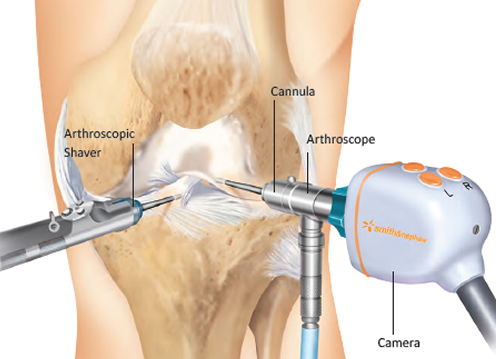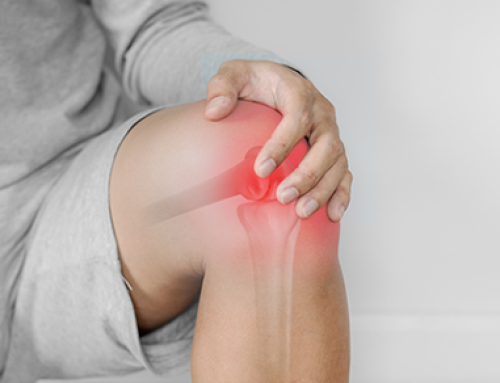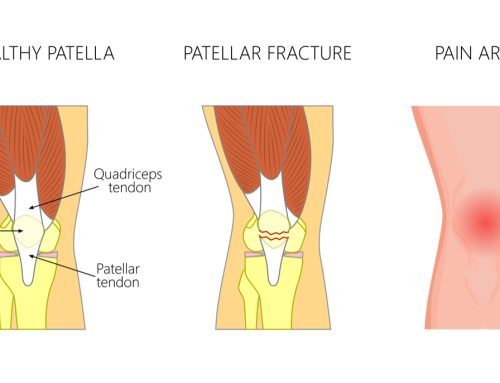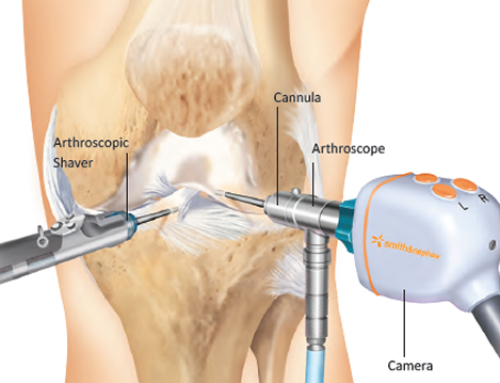Knee Arthroscopy is a surgical technique that can diagnose and treat problems in the kneejoint. During the procedure, your surgeon will make a very small incision and insert a tiny camera called an arthroscope into yourknee. This allows them to view the inside of the joint on a screen.

Knee Arthroscopy is a surgical technique that can diagnose and treat problems in the kneejoint. During the procedure, your surgeon will make a very small incision and insert a tiny camera called an arthroscope into yourknee. This allows them to view the inside of the joint on a screen.

Your doctor may recommend you have a knee arthroscopy if you have ongoing knee pain and other symptoms. If you have a knee arthroscopy, your surgeon will look inside your knee with a camera.
Knee arthroscopy may not make your knee pain and stiffness better if you already have osteoarthritis. So it’s not often recommended to people who only have osteoarthritis pain. But you may be offered an arthroscopy if:
you have osteoarthritis and your knee also catches or gives way
weight loss and exercise haven’t helped your osteoarthritis after at least three months
During a knee arthroscopy, your surgeon may also:
treat your knee – your surgeon may repair or remove any damaged tissue and cartilage
take small tissue samples (biopsies), which may help to diagnose problems such as an infection
do some more complicated surgery, including surgery to repair torn knee ligaments or to treat an unstable kneecap
Your surgeon will use an arthroscope (a thin metal tube containing a camera) and small surgical instruments during your knee surgery. Images are shown on a screen. Your surgeon or doctor can save these images to show you what’s wrong with your knee after your surgery.
You should recover more quickly from knee arthroscopy than if you have open knee surgery.
Before your knee arthroscopy, you’ll meet the surgeon to discuss your operation. This may be different from what’s described here because your operation will be designed to meet your individual needs. Your surgeon will explain how you can prepare for your operation in advance.
If you smoke, you’ll be asked to stop. Smoking makes you more likely to get an infection after surgery, which can slow down your recovery. It can also make your surgery less likely to work and more likely to lead to complications. Knee arthroscopy is usually done under a general anaesthetic, but you may be able to have it under local anaesthetic. A local anaesthetic numbs your knee and you’ll stay awake during surgery. If you have a general anaesthetic, you’ll be asleep during the procedure. A general anaesthetic can make you sick, so it’s important not to eat or drink anything for a specific amount of time before your arthroscopy. Your healthcare team will give you clear instructions about this.
You may be asked to wear a compression stocking on your other (unaffected) leg. This will help to prevent blood clots forming in the veins in your leg, which can cause deep vein thrombosis (DVT). You may need to have an injection of an anti-clotting medicine (or tablets) as well.
You’ll usually be able to have knee arthroscopy and go home from hospital on the same day. But if you’ve had a regional anaesthetic (a local anaesthetic that numbs a wider area of your leg), you may need to stay overnight. You’ll be able to leave the hospital once you can walk well enough again.
Your surgeon will discuss with you what will happen before, during and after your surgery. If you’re unsure about anything, don’t be afraid to ask. No question is too small. It’s important that you feel fully informed, so you feel happy to give your consent for the operation to go ahead. You may be asked to do this by signing a consent form.
Your doctor may be able to diagnose your knee problem by examining your knee, or by doing an X-ray or a magnetic resonance imaging (MRI) scan.
Some knee problems can be treated using physiotherapy and medicines.
Knee arthroscopy usually takes less than an hour. But this depends on how much work your surgeon needs to do inside your knee joint.
You’ll be lying down on a table with your knee in a position so your surgeon can see it clearly. Your surgeon will wait for the anaesthetic to start working. Then they’ll make two or three small cuts (incisions) in the skin around your knee.
They’ll put sterile fluid into your knee joint to rinse it out. This will help them to see the inside of your knee more clearly. They’ll then put in the arthroscope (thin metal tube containing a camera) and examine your knee joint by looking at images on a TV monitor.
Your surgeon will move the arthroscope around your entire knee, so they don’t miss anything they need to look at. They may take some photographs. Once they’ve diagnosed the problem, most conditions will be treated at that time.
They may use other surgical tools to repair or remove any damaged tissue, such as cartilage.
Once they’ve finished looking inside your knee, your surgeon will drain the fluid out. Then they’ll close the cuts with stitches or sticky strips and wrap a dressing around your knee. They may also inject local anaesthetic into your knee (around the cuts) when they are finished for pain relief.
You’ll need to rest until the effects of the anaesthetic have worn off. It may take several hours before the feeling comes back into your knee. Take care not to bump or knock it.
You may notice some discomfort as the anaesthetic wears off and also some swelling. This is a normal response to surgery. You’ll be offered pain relief as you need it.
You’ll usually be able to go home when you feel ready. Make sure someone can take you home. Ask someone to stay with you for a day or so while the anaesthetic wears off.
You may not be able to put weight on your leg for up to a week after your surgery, so you may need some help to stand or walk. Your hospital may give you crutches or a walking frame to take home. Your surgeon or nurse will give you advice on how to use these, and for how long.
A physiotherapist may give you some exercises to do. These will help you to move your knee and stop it getting stiff. Keep doing these exercises when you get home, as they’ll help you recover more quickly.
Your nurse will give you some advice about caring for your healing wounds before you go home. You’ll usually have two to four cuts around your kneecap. These will be covered with a waterproof dressing. Your wounds will be closed with stitches or skin glue. How long it takes for dissolvable stitches to disappear depends on which type you have. If you have non-dissolvable stitches, these are usually removed by the practice nurse at your GP surgery a week or two after your surgery.
You may be asked to wear a compression stocking while you recover. This will improve blood flow in your leg and reduce your chances of getting a blood clot (deep vein thrombosis, DVT).
You may be given a date for a follow-up appointment. This will usually be six weeks after your surgery.
Recovering from knee arthroscopy
Everyone recovers from knee arthroscopy differently. How long it takes you to recover will depend on lots of things, including whether you had any treatment during your knee surgery. It takes most people two to six weeks to recovery completely. You may feel more tired than usual, so don’t do too much too soon. Ask your friends, family and neighbours to help you with practical tasks, such as food shopping or lifting heavy items.
After knee joint surgery, your knee is likely to feel sore and swollen. Try keeping your leg up and applying a cold compress, such as ice or a bag of frozen peas. This may help to reduce swelling and bruising. Don’t put ice directly onto your skin as it can damage it; wrap it in a towel first.
After the first 48 hours, you may be able to take the dressing off and uncover your cuts. You may be able to get them wet around this time too. Your surgeon or nurse will tell you exactly when you can have a bath or shower.
If you need pain relief, you can take over-the-counter painkillers, such as paracetamol or ibuprofen. Always read the patient information that comes with your medicine. If you’re worried about anything, or have any questions, ask your pharmacist for advice.
A general anaesthetic can affect you in many ways. You may find you’re not so co-ordinated or that it’s difficult to think clearly. This should pass within 24 hours. In the meantime, don’t drive, drink alcohol, operate machinery or sign anything important. Always follow your surgeon’s advice.
You may be able to walk around almost straight after your surgery. But this will depend on why you had surgery and the type of surgery you had. Some surgeons recommend a week or two of rest, followed by gentle exercise and then sports later on.
After around two to three weeks, you may be able to do some more strenuous activities. Stick to walking, swimming, gentle cycling and light exercise, as long as you’re comfortable. If you’re swimming, you may find breaststroke difficult. Avoid impact sports for at least six weeks, and always check with your surgeon first. You may not be able to do some sports for the first six months. Surgeons often have a post-surgery exercise plan that you can follow.
You may feel ready to drive again by around the third week after keyhole knee surgery, but follow your surgeon’s advice. It’s important to let your insurance company know about your arthroscopy. Some companies have strict policies and won’t insure a driver until several weeks after their surgery.
Getting back to work or your daily routine may help you recover more quickly. But how much time you need to take off work after your knee surgery will depend on your job. If you work in an office, you may be able to go back to work within a week or two. If your job involves heavy physical work, you may need to take up to six weeks off. Your surgeon and employer should be able to advise you.
You should avoid travelling by air for at least four to six days after your surgery. If you want to travel, you may have to delay your trip because of the risk of developing deep vein thrombosis (DVT). This will depend on whether you have any other risk factors for DVT (such as your age) and the length of your flight. After having knee surgery under a general anaesthetic, your risk of DVT is much higher than if you hadn’t had surgery.
What are the complications?
Knee arthroscopy can cause a few complications. These include:
deep vein thrombosis (DVT)
an infection inside your knee joint
clear fluid leaking into your joint and out onto your skin
damage to the nerves in your skin, which can lead to you losing the feeling in the skin over your knee
muscle weakness – this can often be treated with physiotherapy
persistent pain
compartment syndrome – this is when pressure builds up in a muscle to dangerous levels
accidental damage to the inside of your knee joint
If you have a torn or damaged cartilage removed from your knee joint during knee arthroscopy, this could make you more prone to osteoarthritis later on.
Frequently asked questions
After your knee arthroscopy, it’s important to exercise regularly to get back your knee’s movement and strength. But you’ll need to build up gradually and take things easy at first.
Your physiotherapist may recommend some exercises for your knee that you can do at home. You may have physiotherapy for several weeks after your operation.
You can start with some gentle exercise, such as walking. This may feel a little uncomfortable at first. After a week or two, you may be able to go for longer walks, swim or have a gentle cycle. Don’t do any high-impact exercises, such as running, for at least six weeks.
You should be able to get back to your usual activities after six weeks. But this will depend on your procedure and what you had done. You may not be able to do certain sports for up to six months. Your surgeon or physiotherapist will give you more information about what you can do.
Knee arthroscopy can be used to treat various knee problems, including severe knee pain. But your knee may not recover completely after surgery. This will depend on why you had the surgery and how badly you had damaged your knee. Your surgeon often won’t know how badly damaged your knee is until they’ve operated on it.
Knee arthroscopy may not make knee pain and stiffness better in people who already have osteoarthritis, which causes wear and tear in your knee joint. So, most surgeons won’t do an arthroscopy for osteoarthritis pain.
If large amounts of damaged cartilage are removed during the procedure, you’re more likely to develop osteoarthritis later on.
Some people do still have some knee pain and stiffness after keyhole knee surgery. But they have fewer symptoms than if they hadn’t had the surgery at all. Your surgeon will explain the pros and cons of surgery to you, before you decide whether or not to go ahead with it.




